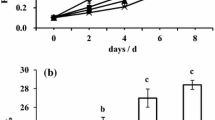Abstract
A red tide due toGymnodinium nagasakiense was observed in August 1988 in Tanabe Bay, Wakayama Prefecture, Japan. The maximum cell concentration ofG. nagasakiense reached 1×105 cells ml−1 at the surface water. From May to September 1988, the following were monitored: water temperature, salinity, chlorophylla, D.O., dissolved nutrients (NO2−N, NO3−N, NH4−N, PO4−P DON, DOP), particulate nutrients (PON, POP) and three dissolved selenium species [Se(IV), Se(VI), Organic Se]. Dissolved inorganic nitrogen (NO3−N, NH4−N) decreased but PON, POP, DON, DOP and inorganic phosphate increased at the peak of the bloom. The concentration of organic selenium increased up to the bloom initiation period which started on 5 July, and then the concentration of Se(IV) increased as the concentration of organic selenium decreased at the peak of the bloom (3 August). The strong relationship was found between the concentration of Se(IV) and the cell concentration ofG. nagasakiense (r 2=0.98). The Se(IV) requirement ofG. nagasakiense was 2.89×10−17 moles cell−1, which was agreed well with 4.4×10−17 moles cell−1 found in a laboratory experiment onG. nagasakiense using selenium spiked artificial sea water medium. The average ratio of Se(IV) to dissolved inorganic nitrogen (DIN) during the red tide bloom was 1∶1441, the ratio of Se(IV) to DIN at the surface with the maximum cell concentration ofG. nagasakiense of 1×105 cells ml−1 was 1∶137. These results suggested that selenium may play an important role in red tide outbreak ofG. nagasakiense.
Similar content being viewed by others
References
Aono, T., Y. Nakaguchi and K. Hiraki (1991): Vertical profiles of dissolved selenium in the North Pacific.Geochem. J.,25, 45–55.
Bendschneider, K. and R. J. Robinson (1952): A new spectrophotometric method for the determination of nitrite in sea water.J. Mar. Res.,11, 87–96.
Cutter, G. A. (1978): Species determination of selenium in natural waters.Anal. Chim. Acta,98, 59–66.
Cutter, G. A. and K. W. Bruland (1984): The marine biogeochemistry of selenium: A re-evaluation.Limnol. Oceanogr.,29, 1179–1192.
Guillard, R. R. L. (1975): Culture of marine invertebrate animals. p. 29–60. ed. by Smith and Chanley, Plenum, New York.
Hattori, A., M. Ohtsu and I. Koike (1983): Distribution, metabolism and budgets of nitrogen in Tokyo Bay.Chikyukagaku (Geochemistry),17, 33–41 (in Japanese).
Hirayama, K. and K. Numaguchi (1972): Growth ofGymnodinium type-'65, causative organism of red tide in Omura Bay, in medium supplied with bottom mud extract.Bull. Plankton Soc. Japan,19, 13–21.
Iizuka, S. and H. Irie (1966): The hydrographic conditions and the fisheries damages by the red water occurred in Omura bay in Summer 1965-II. The biological aspects of a dominant species in the red water.Bull. Fac. Fish., Nagasaki Univ.,21, 67–101 (in Japanese).
Iizuka, S. and H. Irie (1969): Anoxic status of bottom water and occurrences ofGymnodinium red water in Omura Bay.Bull. Plankton Soc. Japan,16, 99–115.
Ishimaru, T., T. Takeuchi, Y. Fukuyo and M. Kodama (1989): The selenium requirement ofGymnodinium nagasakiense. p. 357–360. InRed Tides: Biology, Environmental Science and Toxicology, ed. by Okaichi, Anderson and Nemoto, Elsevier Sci. Publ. Co. Inc., Amsterdam.
Jeffrey, S. W. and G. F. Humphrey (1975): New spectrometric equations for determining chlorophylla, b, c1 andc2 in higher plants, algae and natural phytoplankton.Biochem. Physiol. Pflanz.,167, 191–194.
Menzel, D. W. and N. Corwin (1965): The measurement of total phosphorus in seawater based on the liberation of organically bound fractions by persulfate oxidation.Limnol. Oceanogr.,10, 280–282.
Milford, J. B. and C. I. Davidson (1985): The size particulate trace element in the atmosphere — A review.J. Air Poll. Cont. Assoc.,35, 1249–1260.
Mizohata, A. and T. Mamuro (1978): Some information about loess aerosol over Japan.Taikiosen gakkaishi,13, 289–297 (in Japanese).
Nakaguchi, Y., K. Hiraki, Y. Tamari, Y. Fukunaga, Y. Nishikawa and T. Shigemastu (1985): Fluorometric determination of inorganic selenium(IV), selenium(VI) and organic selenium in natural waters.Anal. Sci.,1, 247–252.
Nishimura, A. (1982): Effect of organic matters produced in fish farms on the growth of red tide algaeGymnodinium type-'65 andChattonella antiqua.Bull. Plankton Soc. Japan,29, 1–7 (in Japanese).
Numaguchi, K. and K. Hirayama (1972): On the suitable pH and chlorinity to the growth ofGymnodinium type-'65, causative organism of the red tide in Omura Bay.Bull. Fac. Fish. Nagasaki Univ.,33, 7–10 (in Japanese).
Ogata, T., T. Ishimaru and M. Kodama (1980): Effect of water temperature and light intensity on growth rate and toxicity change inProtogonyaulax tamarensis.Mar. Biol.,95, 217–220.
Sillén, L. G. (1961): The physical chemistry of sea water. p. 549–582. InOceanography, ed. by M. Sears, AAAS, Wash., D.C.
Solórzano, L. (1969): Determination of ammonia in natural waters by the phenolhypochlorite method.Limnol. Oceanogr.,14, 799–801.
Strickland, J. D. H. and T. R. Parsons (1972):A Practical Handbook of Seawater Analysis. 2nd ed. Fish. Res. Bd. Canada Bull., 167, Ottawa, 311 pp.
Sugimura, Y. and Y. Suzuki (1977): A new fluorometric method of analysis of selenium in sea water.J. Oceanogr. Soc. Japan,33, 23–29.
Takayanagi, K., and G. T. F. Wong (1985): Dissolved inorganic and organic selenium in the Orca Basin.Geochim. Cosmochim. Acta,49, 539–546.
Tsunogai, S. (1983): Behavior of chemicals in the bottom of the coastal area. p. 201–232. InEnvironmental Science for the Coastal Sea Protection, ed. by T. Hirano, Koseisha Koseikaku, Tokyo (in Japanese).
Wood, E. D., F. A. J. Armstrong and F. A. Richards (1967): Determination of nitrate in sea water by cadmium copper reduction to nitrite.J. Mar. Biol. Ass. U.K.,47, 23–31.
Yoshii, O., K. Hiraki, Y. Nishikawa and T. Shigemastu (1977): Fluorometric determination of selenium(IV) and selenium(VI) in sea water and river water.Bunseki Kagaku,26, 91–96 (in Japanese).
Author information
Authors and Affiliations
Rights and permissions
About this article
Cite this article
Koike, Y., Nakaguchi, Y., Hiraki, K. et al. Species and concentrations of selenium and nutrients in Tanabe Bay during red tide due toGymnodinium nagasakiense . J Oceanogr 49, 641–656 (1993). https://doi.org/10.1007/BF02276749
Received:
Revised:
Accepted:
Issue Date:
DOI: https://doi.org/10.1007/BF02276749




